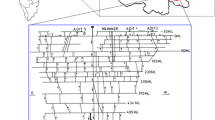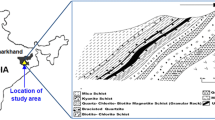Abstract
This study aims to evaluate the effect of various ventilation parameters on radon concentration and inhalation exposure of miners in underground uranium mines. The study carried out at Jaduguda mine revealed that the airflow rate plays a significant role in controlling the radon and its daughter concentrations in the mine. The equilibrium equivalent radon concentration in the mine stopes varied from 180 to 402 Bq m−3. Under existing ventilation condition of the mine, the average inhalation exposure of miners was estimated to be 0.42 WLM year−1, which is about 10 % of the current threshold limit of 4 WLM year−1.



Similar content being viewed by others
References
Krane KS (1987) Introductory nuclear physics. Wiley, New York
IAEA (International Atomic Energy Agency) (2004) Occupational radiation protection in the mining and processing of raw materials. Safety Standards Series No. RS-G-1.6, STI/PUB/1183, Vienna
ICRP (International Commission on Radiological Protection) (1986) Radiation protection of workers in mines. ICRP Publication 47, Ann ICRP 16 (1)
ICRP (International Commission on Radiological Protection) (1993) Protection against radon at home and at work. ICRP Publication 65, Ann ICRP 23(2)
IAEA (International Atomic Energy Agency) (1989) Radiation monitoring in the mining and milling of radioactive ores. IAEA Safety Series No. 95, Vienna
UNSCEAR (United Nations Scientific Committee on the Effects of Atomic Radiation) (2000) Sources and effects of ionizing radiation. Report to the General Assembly of United Nations with scientific annexes, vol. I, New York
Bossard FC, LeFever JJ, LeFever JB, Stout KS (1982) Radon gas emissions and radon daughter working level build-up with air-transit time. Floyd C. Bossard & Associates Inc, Butte, pp 33.1–33.19
Lubin JH, Boice JD Jr, Edling C, Hornung RW, Howe G, Kunz E, Kusiak RA, Morrison HI, Radford EP, Samet JM et al (1995) Health Phys 69:494–500
Lubin JH, Boice JD Jr, Edling C, Hornung RW, Howe G, Kunz E et al (1994) Radon and lung cancer risk: a joint analysis of 11underground miners studies. U.S. Department of Health and Human Services, Public Health Service, National Institutes of Health, NIH Pub No. 94–3644, Washington
BEIR (Biological Effects of Ionizing Radiation) (1988) Report of a committee of the national research council. BEIR IV, National Academy Press, Washington
BEIR (Biological Effects of Ionizing Radiation) (1999) Health effects of exposure to radon. BEIR VI National Academy Press, Washington, DC
Al-Zoughool M, Krewski D (2009) Int J Radiat Bio 85:57–69
Mishra DP, Sahu P, Panigrahi DC, Jha VN, Patnaik RL (2014) Environ Sci Pollut Res 21:2305–2312
Sahu P, Mishra DP, Panigrahi DC, Jha VN, Patnaik RL, Sethy NK (2014) J Environ Radioact 130:15–21
Misaqi FL (1975) Monitoring radon-222 content of mine waters. U.S. Department of the Interior, Mining Enforcement and Safety Administration
Franklin JC, Musulin CS, Bates RC (1980) In: Mousset-Jones P (ed) Proceedings of second international mine ventilation congress, Washington, pp 405–411
Musulin CS, Franklin JC, Thomas VW (1982) Effect of the diurnal cycle and fan shut downs on radon concentration in an experimental uranium mine. Report of Investigations 8663, US Department of the Interior, Bureau of Mines, pp 1 – 13
Schroeder GL (1965) Effect of applied pressures on the radon characteristics of an underground mine environment. Ph.D Thesis, Massachusetts Institute of Technology, Cambridge
Rock RL, Walker DK (1970) Controlling employee exposure to alpha radiation in underground mines, vol. 1. bureau of mines, U.S. Department of the Interior
Schroeder GL, Evans RD (1969) AIME Trans 244:301–307
Haasbroek AC, Du Toit RSJ (1973) Radon in uranium mining: effects of protective controls on uranium resources in South African mines. A Panel on Radon in Uranium Mining, IAEA-PL-565/9, STI/PUB/391, IAEA, Vienna, 4–7 Sept, pp 49–55
Panigrahi DC, Gupta R, Bhowmik SC (2005) In: Gilleis ADS (ed) Proceedings of 8th international mine ventilation congress, Brisbane, Australia, 6–8 July, pp 439–445
Patnaik RL, Srivastava VS, Jha VN, Shukla AK, Tripathi RM, Puranik VD (2009) In: Panigrahi DC (ed) Proceedings of 9th international mine ventilation congress, Vol. 2, 10–13 Nov, New Delhi
Khan AH, Puranik VD (2012) In: Schipek M, Merkel BJ (eds) The new uranium mining boom. Springer, Berlin, pp 39–49
Raghavayya M (1981) Health Phys 40:894–896
IAEA (International Atomic Energy Agency) (1996) International basic safety standards for protection against ionising radiation and for the safety of radiation sources. IAEA Safety Series No. 115, Vienna
Eappen KP, Mayya YS, Patnaik RL, Kushwaha HS (2006) Radiat Meas 41:342–348
Panigrahi DC, Sahu P, Mishra DP, Jha VN, Patnaik RL (2014) J Radioanal Nucl Chem 302:433–439
ICRP (International Commission on Radiological Protection) (2007) The 2007 recommendations of the international commission on radiological protection. ICRP Publication 103, Ann ICRP 37 (2)
IAEA (International Atomic Energy Agency) (2003) Radiation protection against radon in workplaces other than mines, vol 33. IAEA, Vienna
WHO (World Health Organization) (2009) Handbook on indoor radon, a public health perspective. http://www.who.int/ionizing_radiation/env/9789241547673/en. Accessed 21 June 2014
Wagoner JK, Archer VE, Carroll BE, Holaday DA, Lawrence PA (1964) J Natl Cancer Inst 32:787–801
Bhasin JL (1999) In: Kher RK, Pushparaja, Sangurdekar PR Thomas K (eds) Proceedings of 24th IARP national conference on radiation protection in nuclear fuel cycle: control of occupational and public exposure, 20–22 Jan, KAPS, Kakarapar, Surat, pp 11–16
Khan AH, Puranik VD, Kushwaha HS (2009) In: International symposium on uranium raw material for the nuclear fuel cycle: Exploration, mining, production, supply and demand, economics and environmental issues, 22–26 June, Vienna IAEA-CN-175/64
Shukla AK, Topno R, Srivastav VS, Patnaik RL, Kumar R, Dandapat BL, Rana BK, Tripathi RM, Puranik VD (2009) In: Panigrahi DC (ed) Proceedings of 9th international mine ventilation congress, Technical papers: Poster session, New Delhi pp 235
Cheng KC, Porritt JWM (1981) CIM Bull 74:110–118
Saccomanno G, Huth GC, Auerbach O, Kuschner M (1988) Cancer 62:1402–1408
Rana BK, Sahoo SK, Ravi PM, Tripathi RM (2014) J Radioanal Nucl Chem 301:9–16
Bennett RH (1980) Personal correspondence; a typical time—weighted mine average and the distribution of radon daughters measured in active stopes of Beaverlodge mine during Oct 1978–Sept 1979
Clarke RH (1995) Health Phys 69:454–460
Raghavayya M (1976) A Study of the distribution of radioactivity in uranium mines. M.Sc Thesis, University of Bombay, Mumbai, India
Morgan MV, Samet JM (1986) Health Phys 50:656–662
Lane RSD, Frost SE, Howe GR, Zablotska LB (2010) Radiat Res 174:773–785
SENES(Specialists in Energy, Nuclear and Environmental Sciences) (2003) Feasibility study: Saskatchewan uranium miners cohort study (part II). Prepared for Canadian Nuclear Safety Commission, Ottawa
Burkart W, Grosche B, Martignoni K (1996) Radiol Prot Bull 175:12–15
Sahu P, Mishra DP, Panigrahi DC, Jha VN, Patnaik RL (2013) J Environ Radioact 126:104–114
Lottermoser BG (2010) Radioactive wastes of uranium ores. Mine wastes: Characterization, Treatment and Environmental Impacts. Springer, Heidelberg, pp 263–309
Kavasi N, Vigh T, Kovacs T, Vaupotic J, Jobbagy V, Ishikawa T, Yonehara H (2011) J Environ Radioact 102:806–812
Nikezic D, Haque AKMM, Yu KN (2002) J Environ Radioact 61:305–318
Porstendorfer J (1994) J Aerosol Sci 2:219–263
Porstendorfer J (1996) Environ Int 22:563–583
Ayer HE (1954) Control of radon and its daughters in mines by ventilation. United Atomic Energy Commission, AECU–2858
IAEA (International Atomic Energy Agency) (1984) Inhalation risks from radioactive contaminants. Technical Reports Series, Publication No. 142, Vienna
Otahal P, Burian I, Vosahlik J (2010) In: Proceedings of Third European IRPA Congress, 14–18 June. Helsinki pp 1–7
Acknowledgments
The authors wish to express their sincere thanks to Mr. D. Acharya, Chairman and Managing Director, Uranium Corporation of Indian Ltd for granting necessary permission to carry out the research work in Jaduguda uranium mine. Authors are also thankful to Dr. V. N. Jha, Officer-in-charge, Health Physics Unit, BARC, Jaduguda for extending all kinds of support for carrying out the experiments.
Author information
Authors and Affiliations
Corresponding author
Rights and permissions
About this article
Cite this article
Sahu, P., Panigrahi, D.C. & Mishra, D.P. Evaluation of effect of ventilation on radon concentration and occupational exposure to radon daughters in low ore grade underground uranium mine. J Radioanal Nucl Chem 303, 1933–1941 (2015). https://doi.org/10.1007/s10967-014-3687-8
Received:
Published:
Issue Date:
DOI: https://doi.org/10.1007/s10967-014-3687-8




